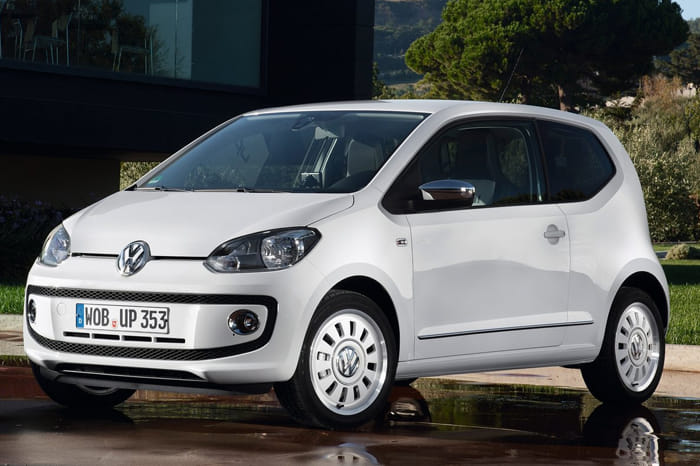Living up to its name, Volkswagen has gone back to its roots with its most serious attempt at a ‘people’s car’ since the Beetle itself. For VW, the all-new Up is a fresh beginning in the budget end of the market and is the smallest and cheapest car in the company’s range.
VW believes that small cars are the way of the future, not just in the mature markets of Europe but in key growth markets like India too, where it will be the auto maker’s main pillar. Hence, the Up’s importance in India and VW’s will to make it succeed here cannot be underestimated.
Curiously, the Up project started off on the wrong foot with the engine in the wrong place. The original plan was to develop a rear-engine, rear-wheel-drive car as this layout cannot be beaten for packaging and sheer space. But to make a stand-alone rear-engine car in the range meant that sharing parts with other models would be limited. Hence, it was in the interests of costs and economies of scale that VW reverted to the transverse front-engine, front-wheel-drive layout.
Launched in three and five door forms, the Up is almost true to the original concept launched in 2007. Like most VWs, the styling is unremarkable and the simple, two-box shape, though pleasing on the eye, won’t turn heads. The upright stance, long wheelbase (2420mm) and short nose point to its practical character and promise of interior space. But the design is not all plain vanilla and there are some interesting details too. The Up’s small engines don’t require large cooling intakes, so it makes do without a grille – there’s a simple, black band that runs between the small but very stylish headlights. What looks unique is the honeycomb frame that surrounds the bumper.
The tailgate has an outer glass cover and vertical tail lights which, though part of the body, look integrated with the hatch. All this makes the Up look lighter from the rear. Speaking of weight, the Up weighs around 930kg, making it as light as the i10 and Brio.
There’s an appealing brightness to the Up’s cabin and VW has smartly used painted panels instead of plastic on the dashboard. Though there is a spartan feel inside without a proper centre stack and fully clad doorpads, this low-cost solution works well and doesn’t feel cheap. In fact, items that you always touch and feel, like the steering wheel, gear-lever and switches, are high-quality bits and the headlight switch feels like it’s been plucked out of a Jetta.
VW has carved out every inch of space in the Up’s cabin to offer generous room for the passengers. But the fact is that this baby VW can never hope to swallow five large adults the way the rear-engined Tata Nano can. But when you consider that the Up will be up against cars like the i10 and Chevy Beat, it is easily the class-leader when it comes to passenger room and comfort.
The front seats with integrated head rests and smartly coloured piping are incredibly comfy and generous. Flipping forward the front seats and jumping into the back is something we won’t have to do in India (only the five-door will come here) but once settled down at the back, we were astonished with the comfort of the back seat. The squab is generous, headroom is decent and although legroom is a bit tight, your feet aren’t cramped. The 251-litre boot is pretty spacious and with a false floor which can divide it into two compartments, it’s clever too.
A new-generation 1-litre, three-cylinder petrol engine (EA211) makes its debut in the Up. This compact and lightweight twin-cam motor is offered in two states of tune in Europe; with 59bhp and 74bhp outputs. A compact diesel is on the cards as well but that won’t come for another year. Though this new petrol engine is pretty sophisticated, there are some cost-saving measures – it doesn’t get sequential injection and makes do without a balance shaft. But when you drive it, you wouldn’t know.
The engine is amazingly refined for a three-cylinder and though that characteristic thrum is always present, it doesn’t amplify into uncomfortable vibrations. It feels a galaxy ahead of Hyundai’s three-cylinder motor in the Eon and is even smoother than Suzuki’s K10. Both the Up’s engines are responsive and quick off the block, but when you want to press on, the 60PS unit, which has a weak bottom, feels a touch sluggish. The 74bhp gives you all the power you need for daily use and on the highway it keeps up with the traffic flow quite well. The five-speed gearbox is as slick as ever and though you have to use it a fair bit, given the limited torque of both motors, it’s never a cause for complaint.
You have to keep reminding yourself you’re in an A-segment car because the mature dynamics and surefooted handling derived from the finely tuned suspension and large wheels is something you just don’t find in this class. If there is a fault it’s that the ride can get choppy on uneven surfaces and the Up pitches quite a bit over undulations. But for most part, the ride is quite pliant. The handling is superb and the Up’s electric steering is one of the best there is.
You can sense that the incredibly user-friendly Up is a winner already and when it comes to India at the end of 2013, it will set new benchmarks in several areas. However the one area where it may struggle is with costs. This car may look basic but it’s got some high-quality content which may make meeting cost targets the biggest challenge. However, you can sense a steely determination in VW to get this one right. This could be bad news for market leader Maruti, whose erstwhile partner could now be its most formidable rival.




